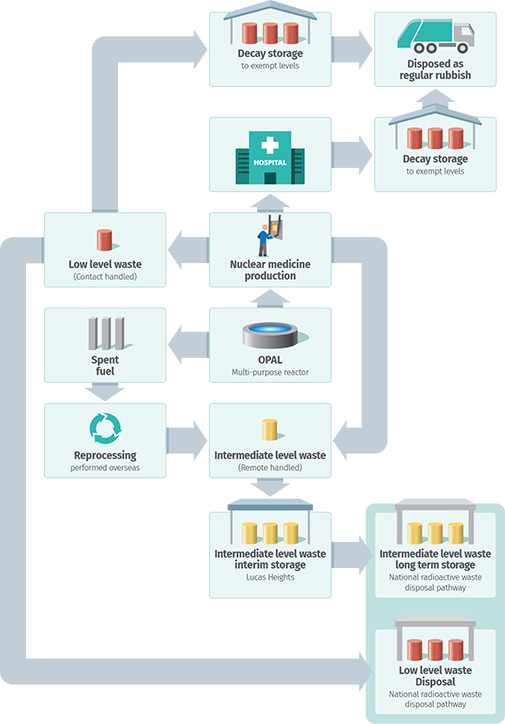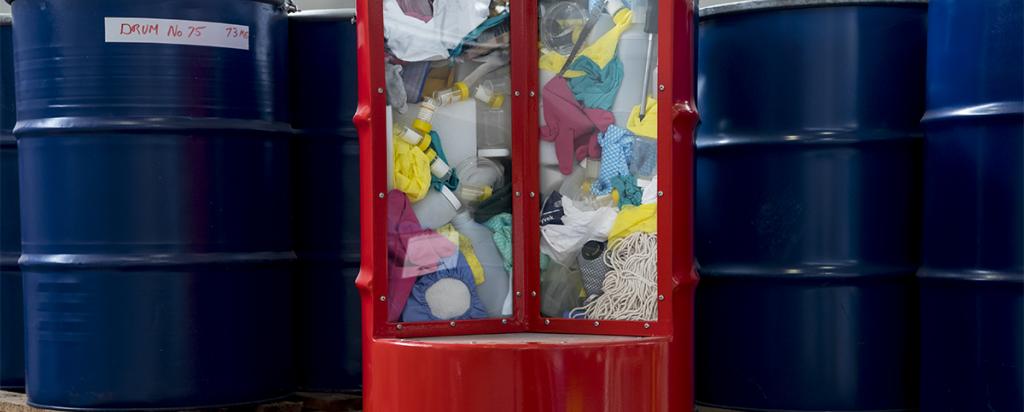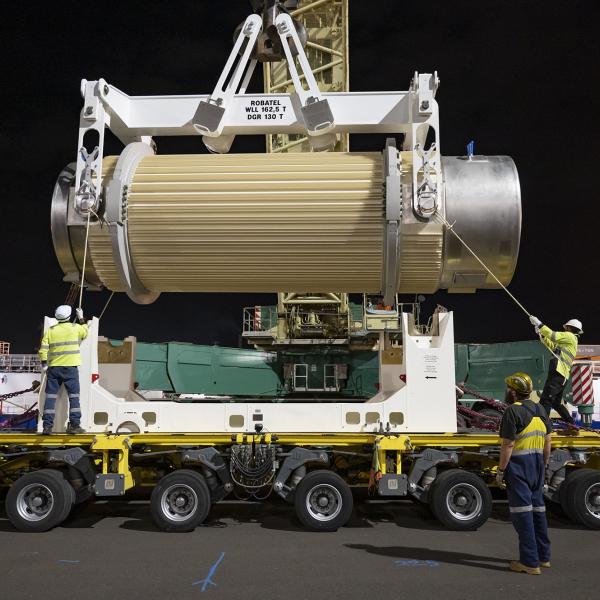

Managing Radioactive Waste
Regulation
ANSTO is regulated by an independent nuclear safety regulator, the Australian Radiation Protection and Nuclear Safety Agency (ARPANSA).
Australia is a member of the International Atomic Energy Agency (IAEA), which sets international standards for safely managing radioactive waste.
What is radioactive waste?
ANSTO’s radioactive waste is a by-product from the production of lifesaving nuclear medicines, and beneficial industrial and research activities. ANSTO produces around 75 – 80 per cent of the nuclear medicines used in Australia, which every Australian, on average, is likely to benefit from at least twice in their lifetime.
Radioactive waste contains radioactive materials that are no longer useful and send out higher levels of radiation than natural background radiation.
Radioactivity gradually diminishes as the radioactive elements decay into more stable elements, so waste gradually becomes less radioactive and safer to handle over time.
The period of time required for radioactive elements to decay is dependent on the half-life of the radioactive element – also known as the nuclide or isotope.
Radioactive waste can be classified into three main categories – low-level, intermediate-level and high-level waste. ANSTO does not produce high-level radioactive waste.
ANSTO is one of more than 100 holders of radioactive waste in Australia, which also includes hospitals, universities, defence sites and science organisations.
Low-level waste
Low-level waste emits radiation at levels which generally require minimal shielding and can be safely handled with standard personal protection equipment (PPE) during handling, transport and storage. Low-level waste is characterised by a contact dose rate of less than 2 millisieverts per hour.
Around 86 per cent of the radioactive waste produced by ANSTO is low-level waste. Low-level waste can be made up of laboratory waste (paper, plastic, gloves, cloths and filters), equipment (metal and plastic), and bulk materials (concrete or soil from building waste) which contain small amounts of radioactivity.
This waste is sorted and placed into 200 litre drums, which are safely stored on-site on an interim basis. Each drum’s radioactivity is measured using a scanning system and logged to help ANSTO understand the different radionuclides present and their decay profile over time.
The drums are bar-coded and the radioactive content of each drum is entered into a database to ensure the waste is safely, securely and efficiently managed in compliance with the standards set by the IAEA and the Australian regulator ARPANSA.
Intermediate-level waste
Intermediate-level waste emits higher levels of radiation and requires additional shielding to protect workers and the environment during handling, transport and storage.
Intermediate-level waste is typically characterised by a contact dose rate of 2 millisieverts per hour and above.
Intermediate-level waste at ANSTO is typically generated from radiopharmaceutical production and research reactor operations.
The return of ANSTO’s radioactive waste from France in 2015 and the UK in 2022, following re-processing of spent reactor fuel, is categorised as intermediate-level waste. It is safely and securely stored at ANSTO in two TN-81 casks on an interim basis.
High-level waste
High-level waste has higher levels of radiation that require increased shielding and isolation from human contact and cooling due to its heat-generating capacity. No high-level waste is produced at ANSTO.
Nuclear medicine waste cycle
The diagram below provides a simplified flowchart of the waste products resulting from the production of nuclear medicine at ANSTO.

Frequently-asked questions
What sort of waste is stored at ANSTO?
ANSTO stores low-level waste and a small amount of intermediate-level waste on-site.
What about used or spent fuel?
Spent fuel from the OPAL research reactor is not categorised as waste in Australia. It is held in the OPAL reactor storage pool until it is ready for shipment overseas, where it is reprocessed to remove uranium and plutonium for re-use in peaceful nuclear programs located in other countries.
Waste residues created during reprocessing in France were returned to Australia as intermediate-level waste in 2015.A second repatriation of radioactive waste was returned to Australia in 2022 from the United Kingdom.
Reprocessed waste is currently stored on an interim basis at ANSTO’s Lucas Heights campus.
Does ANSTO manage all the radioactive waste in Australia?
No. Radioactive waste is managed at over 100 locations around Australia, including ANSTO, hospitals, universities, and national science and defence facilities. ANSTO manages the overwhelming majority of the low-level and intermediate-level radioactive waste in Australia.
All radioactive waste in Australia is managed in accordance with national and international standards. The management of waste generated by Commonwealth bodies, including ANSTO, is regulated by the independent safety regulator, the Australian Radiation Protection and Nuclear Safety Agency (ARPANSA).
State and local Governments, private companies, and individuals that hold radioactive waste are regulated by the local radiation protection regulator (usually an agency responsible for environmental protection or health) in each state or territory.
More information about the management of radioactive waste in Australia can be found at the Australian Radioactive Waste Agency website.

Management of nuclear reactor fuel
ANSTO has safely and responsibly managed spent nuclear fuel and its resulting radioactive waste from its three nuclear research reactors (HIFAR, Moata, and OPAL) since the 1950s.
Learn more